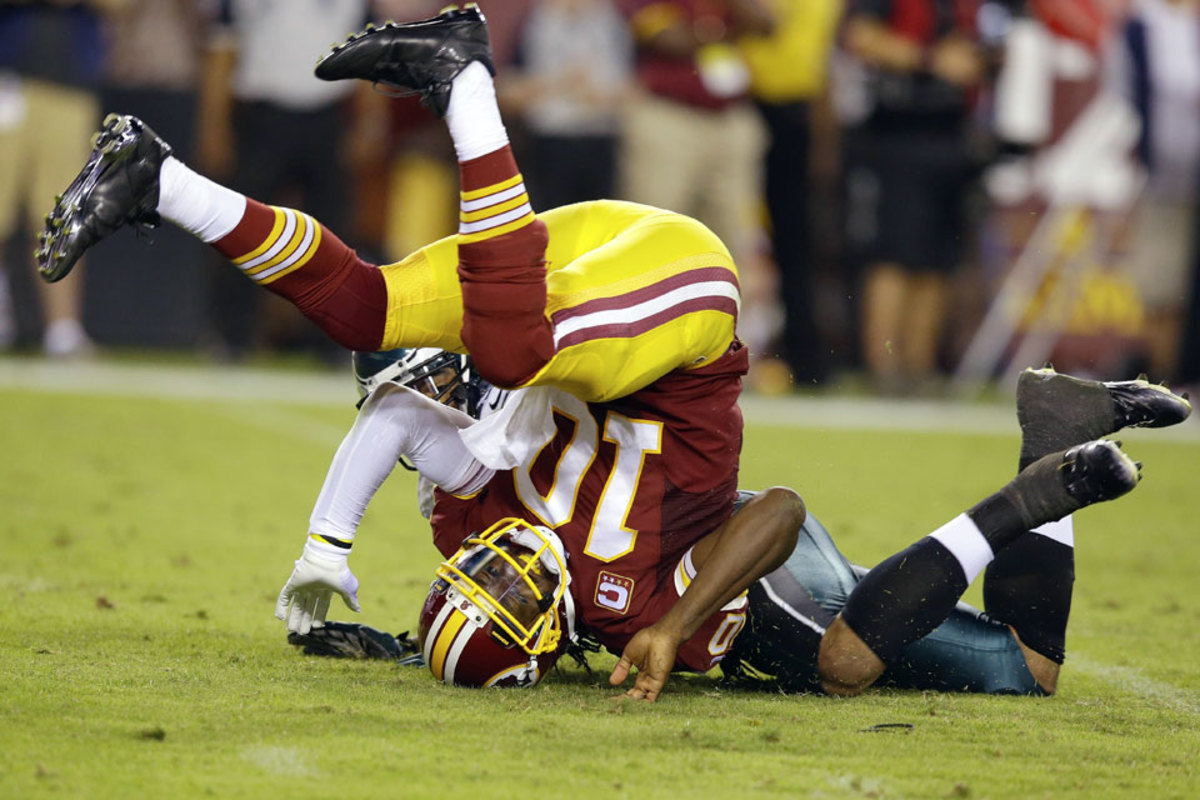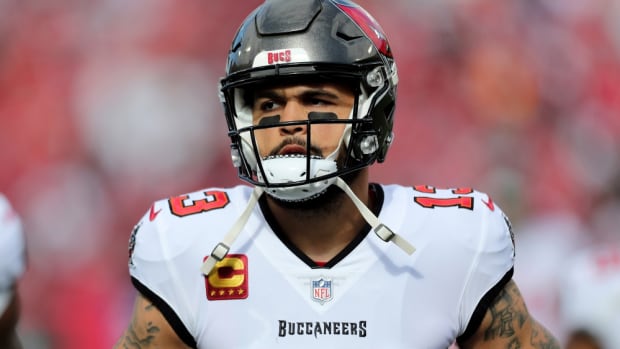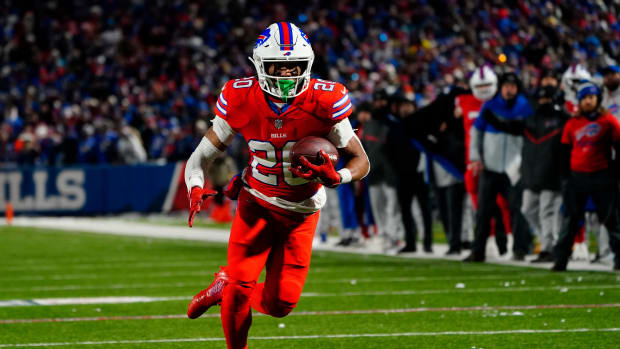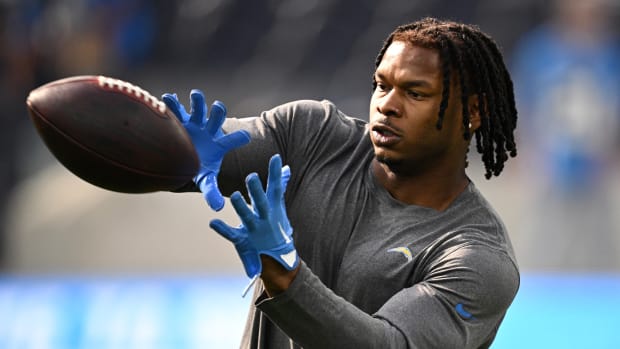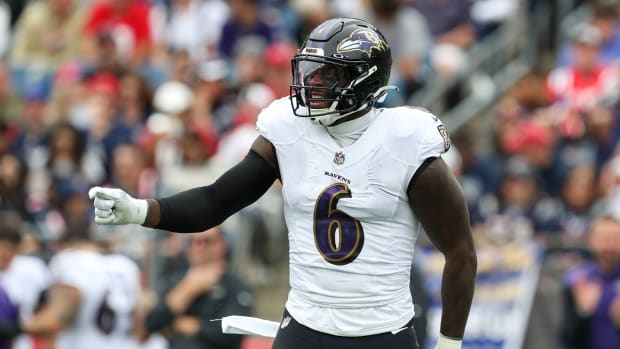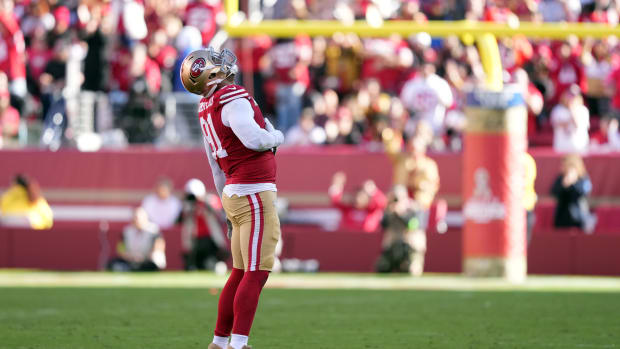The Read-Option As We Know It Is Dead
How would quarterback Robert Griffin III look in his return from major reconstructive knee surgery? Would Washington put its second-year star at risk by continuing to run its vaunted read-option? These questions were among the most asked by NFL fans entering the new season, but the latter remains unanswered following the Redskins’ 33-27 loss to the Eagles last Monday night. Philadelphia led by 19 at halftime and Washington committed three turnovers (including two picks by a rusty RG3), forcing head coach and offensive coordinator Mike and Kyle Shanahan to abandon the run.
We may not see Washington’s read-option in Week 2 either, not after the Packers took away the 49ers’ read-option last Sunday. Green Bay had its weak outside edge defender ambush quarterback Colin Kaepernick at the snap. If that defender was left unblocked, he had an unimpeded path to deliver a thundering hit. Consequently, the Niners used a true read-option on just a handful of plays. Kaepernick was drilled for a loss of seven yards and two yards on the two times he kept the ball; another time, running back Kendall Hunter was tackled for a loss of seven by an unblocked Clay Matthews, who was on his way to Kaepernick.
In time we’ll look back and view this as the beginning of the end for the read-option as we know it. The quarterback no longer has enough time to ride the mesh point because the unblocked defender is no longer reacting to the action, he’s now dictating it. This doesn’t mean read-option concepts will disappear. In fact, the scheme might still be in its infantile stages. Even if mobile quarterbacks like Griffin are no longer be asked to read unblocked edge defenders, they can still influence defenses by executing read-option motions (i.e. riding the mesh point on handoffs or QB keepers) on traditional run plays out of the Pistol formation. Such a wrinkle still presents the defense with added dimensions to think about.
Washington actually used these dummy looks on a regular basis last year. Often, plays that appeared to be read-options were straight huddle calls, with Griffin only pretending to read the unblocked defender. They worked just as effectively, if not better, than actual read-options. Here are but a few examples:
Last season, the unblocked edge defender was a read-option offense’s target for manipulation. Now that offenses will have to start blocking those edge defenders, inside linebackers and safeties will become the new targets. What this could mean is the read-option, which was originally thought to revolutionize the running game, will have its greatest impact on the passing game. Essentially, it could become a new form of play-action.
We’ve already seen the early stages of this. Last season, Washington’s offense used play-action on 42% of its snaps, the highest total the NFL has seen since Football Outsiders started tracking the stat in 1991. Washington averaged 10.1 yards on these plays. However, most of those play-action passes resulted from Griffin doing a traditional fake handoff in the pistol formation. Linebackers would instinctively bite, and RG3 would fire a seven-to-nine-yard quick slant in their vacated areas.
In the next phase, we could see play-action take the form of the elongated read-option looks. (The Packers saw hints of this last Sunday, as Kaepernick completed 8 of 10 passes for 122 yards and two touchdowns on play-action passes, many of which came from the Pistol and exploited man coverage on deeper downfield levels.) Though Kaepernick didn’t prolong his ball fakes against Green Bay, the idea would be to ride the mesh point long enough to get linebackers to bite and the safeties to freeze. The timing of the play—especially for linemen trying to sell a run block—would be very similar to a traditional seven-step play-action, except the quarterback wouldn't have to turn his back to the defense. The timing of current play-action passes out of the Pistol are closer to traditional three- and five-step drops, which means shorter routes.
Washington may not have to get über-creative to create vertical opportunities this Sunday. The Packers defense gave up a league-high three completions on passes where the ball traveled at least 20 yards downfield last week. If Griffin can rediscover enough of his confidence and rhythm to start planting and stepping into his throws, downfield shots should be available. Manufacturing those shots off of a true read-option look would be an innovative next step for the Shanahans to take.
SUNDAY SLATE: GAME BY GAME ANALYSIS
Rams @ Falcons
One concern with Atlanta’s defense coming into this season was its linebackers in coverage. They were torn apart by tight ends in the playoffs. In the season opener against New Orleans, with Stephen Nicholas sidelined with a thigh injury, defensive lineman Kroy Biermann played strong outside backer in the base D, while run-oriented middle linebacker Akeem Dent got snaps in nickel. Neither is a particularly comfortable pass defender, but with help from safeties in the box and, when possible, jams off the line, Atlanta held Jimmy Graham to 45 yards on four receptions (one went for a touchdown). This week, the Falcons are facing a similar versatile weapon in St. Louis’s Jared Cook. The $35 million free agent erupted for 141 yards and two touchdowns in his Rams debut. As with Graham, the Falcons can expect to see Cook line up all over the formation this week.
Panthers @ Bills
People are quickly falling out of love with Cam Newton. Just two years ago, the mobile 6-5, 245-pound quarterback took the NFL by storm. Now there’s a new 6-5, 240-pound run-pass threat for people to fall for (or at least flirt with) in EJ Manuel. The Bills’ first-round rookie is unrefined in a lot of his mechanics, but unlike Newton, he hasn’t had two full NFL seasons to improve (or in Newton’s case, not improve). Also unlike Newton, Manuel isn’t coming off a disappointing Week 1 performance in which he left too many open receivers on the field. (Then again, Buffalo’s wideouts didn’t exactly get open against the Patriots.)
Vikings @ Bears
For Bears fans, the fact that their team did not give up a single sack was almost as exciting as Chicago’s come-from-behind victory over a good Bengals squad in Week 1. The last time that happened in a Bears’ season opener was 1998. All the more impressive, the Bears started a pair of rookie linemen on the right side: first-rounder Kyle Long at guard and fifth-rounder Jordan Mills at tackle. And they were facing a blitz-happy Bengals defense that is loaded across the front four and coming off a 51-sack season (one behind Denver and St. Louis for the NFL lead). Aside from a few protection cracks on the right side in the first half, quarterback Jay Cutler operated in an uninvaded pocket. The Bears will need another encouraging pass-blocking performance this week against a Vikings’ front four that boasts quality rushers off both edges in Jared Allen and Brian Robison.
Dolphins @ Colts
When these teams met in Week 9 last year, quarterback Andrew Luck threw for a rookie record 433 yards, including a staggering six conversions on third-and-10-or-longer. Luck dominated with his most underrated attribute: the ability to buy time, maneuvering in the pocket or escaping it in order to make downfield throws late in the play. Of course, Luck was playing in Bruce Arians’s aggressive, multipronged offense last season. This year, he’s working in Pep Hamilton’s more conventional run-oriented West Coast-style system. (Against the Raiders last week, Luck dropped back 31 times, just five more times than he handed off.) He’s also facing a Dolphins defense that has a stouter pass-rush (third overall pick Dion Jordan had a sack in his NFL debut) and a revamped secondary that stifled the Browns’ (albeit iffy) receiving corps last week.
Cowboys @ Chiefs
It’s a homecoming for Brandon Carr, one of the most underappreciated press-corners in football who played his first four seasons in Kansas City before joining Dallas in 2012. Carr had a laudable performance in Monte Kiffin’s new scheme against the Giants on Sunday night. Though Kiffin is a zone-based coach, he is mainly using the Seahawks’ hybrid 4-3 man-zone scheme, with his corners playing outside technique but in a man-press type position. With a single-high safety, the only help the corners have comes from underneath second-level zone defenders. This seems risky, but is a sound approach with the right personnel. But as the Giants showed throughout the second half, it can leave the defense vulnerable against 12- to 16-yard slants. That’s a route Dwayne Bowe has always run well. It will be interesting to see if Kiffin has Carr—who is clearly Dallas’s best corner, especially with Morris Claiborne battling a bum shoulder and playing on a sore knee—shadow Bowe or whether he keeps his defenders on set sides of the field.
Chargers @ Eagles
As teams become more familiar with Chip Kelly’s offense, defensive coordinators will choose to be proactive against Philadelphia’s rapid-pace. The Redskins only came close to disrupting the Eagles’ hurry-up rhythm on Monday night when they dialed up blitzes on the right side, attacking the athletic but inexperienced rookie Lane Johnson at tackle. Keep in mind, Philly’s offensive linemen don’t have time to identify pressure looks when the ball is snapped quickly; that’s partly why Eagles go with zone blocking instead of man. And quarterback Michael Vick has never been great at identifying blitzes with his presnap reads. The question is whether the Chargers, on a short week, can install pressure concepts into the default base schemes that Philadelphia’s tempo will force them to use.
Browns @ Ravens
If Week 1 is any indication, this may look more like a Pee Wee game, as neither team has wide receivers who can consistently get open or catch the football. This has long been a problem for both clubs. The Ravens got away with it last year because their most reliable receiver, Anquan Boldin (now with the 49ers), is one of the rare players who is so strong he doesn’t need to be “open” in order to make catches. You can’t say the same about Torrey Smith, who has top-end speed but lacks the initial quickness to create separation at the intermediate levels. Browns wideouts Greg Little and Josh Gordon (who is serving the last part of his two-game suspension for violating the league’s substance abuse policy this week) have the speed as well as the size to make contested catches, but unlike Boldin, they haven’t grasped the nuances of their position to yet do so. Both of these defenses used a lot of man-to-man coverage in Week 1. They have every reason to do so again in Week 2.
Titans @ Texans
Something to keep an eye on: Houston’s new use of 3 x 1 closed formations. That is, three receivers lined up to one side of the field, opposite a tight end aligned in his standard spot next to a tackle on the other side of the field. It looks like a passing formation, but in Week 1, the Texans mostly ran from it.
Saints @ Bucs
When rookie coach Greg Schiano faced the Saints for the first time last year in Week 7, the Bucs played a lot of seven- and eight-man zone coverages. Schiano learned that’s not a great approach against this offense because it allows Drew Brees more than enough time to work through his progressions (which is exactly what the seven-time Pro Bowler does best). When the teams met again in Week 15, the Bucs changed up their defensive looks, switching between man-free and Cover 2. But injuries had depleted their secondary and pass rush, leaving them unequipped to match up against New Orleans’s aerial weapons. With both teams at full strength this weekend, Tampa Bay’s approach could say a lot about what kind of defense Schiano plans on employing in 2013.
Lions @ Cardinals
Maybe Reggie Bush won’t rush for 90 yards and catch more than 100 every week, but his debut with Detroit was no mirage against the Vikings. Bush is one of the few players in the league with a skill-set similar to that of Jahvid Best, and this offense has been waiting almost two years for someone to fill that role. When the Lions were first piecing together their Scott Linehan-led offense, the crucial supporting element around the Matthew Stafford-Calvin Johnson tandem was Best—a shifty, space-oriented scatback who was equally adept carrying the ball out of the backfield and catching passes on receiver-type routes. When Stafford finally got healthy in 2011, the Lions opened the season 5-0. Those happened to be the only five games that Best was healthy that year. He averaged 19 touches and 112 yards from scrimmage in those contests until concussion problems derailed his career.
Jaguars @ Raiders
One of the many profound points John Madden used to make during his broadcasting career was that mobility is a key asset for a young quarterback, because it serves as a crutch for when he drops back and has no idea how to read the defense. Good quarterbacks eventually learn to recognize what they’re seeing, but until they’ve mastered the skill, the mobile ones at least have the ability to turn bad plays into positive gains. This game will provide a great snapshot of how significant this can be. Both of these offenses have questionable lines and sub-par receiving corps. And both have undeveloped young quarterbacks. Oakland’s Terrelle Pryor is mobile and rushed for 112 yards in Week 1. Jacksonville’s Blaine Gabbert was sacked six times.
Broncos @ Giants
With Von Miller serving his six-game suspension for violating the league’s substance-abuse policy, and with Elvis Dumervil now in Baltimore, people were skeptical about how the Broncos would generate a pass-rush early in the season. In Week 1, they didn’t—at least not using four basic rushers when the game was still close. But as the score became lopsided and the Ravens had to throw, defensive coordinator Jack Del Rio started uncorking the multipronged, multilevel sub-package blitzes that helped the Broncos record a league-leading 52 sacks last year. Even without cornerback Champ Bailey, who hopes to return this week from a foot injury, Del Rio was able to play this way because his secondary had no trouble stifling the Ravens in man coverage.
Contrast that with the Giants, a team known for usually having a potent four-man rush that hides its ho-hum secondary. They generated almost no pressure against a shaky Cowboys O-line on Sunday night. It’s not a new thing, either. Their inconsistency in generating pressure was disconcerting last season as well. Given the way Peyton Manning moves in the pocket and anticipates throwing lanes early in his progressions, he shouldn’t expect to see much pressure Sunday afternoon.
49ers @ Seahawks
Colin Kaepernick had a career-high 412 passing yards against a Packers secondary last Sunday that was missing ace slot corner Casey Hayward (hamstring) and top safety Morgan Burnett (hamstring). Head coach Jim Harbaugh and offensive coordinator Greg Roman correctly anticipated that Green Bay would show a lot of man coverage, and they had the perfect route combinations to attack it.
































